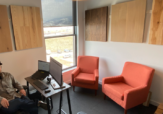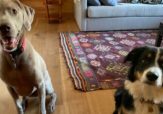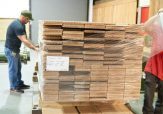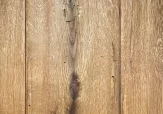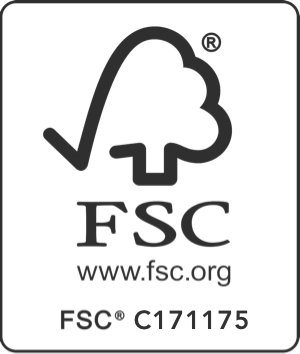How to Clean and Care for Your Hardwood Floor
Keeping your wood floors looking great can feel like an epic battle against gravity. Gravity is the magnet that pulls every type of dirt, dust, grit, and dropped food item directly to your floor. Gravity deposits the chewing gum on the ground that gets stuck to your boot that then smears it across the living room floor. Gravity pulls earthward the chairs and tables that scratch your floor when you move them. Gravity drives the rain through the open window and into the puddle that collects on your bedroom floor. And gravity tethers your dog and kids in close proximity to the floor, so their paws and building blocks and hockey sticks can scuff and scrape the family room flooring.
Before you throw yourself down on the floor (with gravity’s help) to kick and scream and pound your fists in frustration, know there are many ways short of rocketing your home into orbit to offset gravity’s incessant pull. Here are some simple steps for keeping your hardwood flooring looking like new.
Pre-Emptive Measures
Hardwood flooring, depending on the species and the type of finish used, can vary greatly in its durability and capacity to withstand all that gravity throws its way. But even the species that are the hardest and most scratch resistant can be helped by some common-sense preemptive measures. The most obvious is the use of coasters and felt pad floor protectors to minimize indentations and scratches from furniture legs. Another is the use of entry mats to help collect the detritus brought inside before it is tracked all over the house. Make sure the protective coverings you use are designed for wood floors, as some rubber-backed mats can trap moisture, damaging floors in the process.
An additional important action you can take is to keep the interior humidity levels between 35% and 55% throughout the year to minimize the natural expansion and contraction of wood. Seasonal humidity extremes can wreak havoc on wood’s hygrothermal tendencies. During the heating season, a humidifier can offset the dry heat produced by electricity or a wood stove and prevent excess shrinkage. And in the more humid summer months, air conditioning or a dehumidifier can help mitigate the moisture that causes excessive expansion and cupping.
Over time, prolonged exposure to direct sunlight can cause some species’ natural coloration to fade, as well as accelerate the aging of the wood. So drawing curtains and shades can offer protection against that. Also, occasionally rearranging your rugs and furniture can allow the flooring to age and wear more evenly.
Other preemptive steps include trimming pet nails regularly, removing shoes with sharp attributes (high heals, cleats, spikes), and protecting the floor or using a dolly when moving heavy objects such as furniture and appliances.
Maintenance Measures
Keeping on top of cleaning your hardwood floors is paramount to keeping them looking great. But this need not be an odious task. Use a soft cloth to blot spills and spots as soon as they happen. Always avoid allowing liquids to stand on your hardwood floor.
A quick sweep or dusting every day or two will keep grit from scratching the surface. A machine washable, electrostatic action, microfiber cleaning pad is the most effective way to attract, trap, and lift the dirt, rather than just pushing it around. For any sticky substances you encounter, such as chewing gum or candle wax, apply ice to harden it, and then scrape it up with a plastic scraper or a credit card.
Add a vacuuming and mopping to your regimen at least once a week. Use the hard floor attachment on your vacuum cleaner rather than a carpet beater bar, which can cause scratches and damage. For mopping, remember that wood and water are a bad combination, so don't wash or wet-mop the floor. This could cause swelling, warping, delamination and joint-line separation. Lightly misting your floor with a hardwood floor cleaner will be enough to give it a great clean.
Also avoid using soap, oil-soap detergent, vinegar, any other liquid cleaning material, wax, polish, or strong ammoniated products, which can dull your floor’s finish. And steer clear of steam cleaners, steel wool, scouring pads, or other abrasive cleaners, all of which can have deleterious impacts on your flooring.
Renewal Measures
After years of use, even the most carefully protected, and regularly cleaned hardwood flooring will inevitably be showing some wear and tear. With most materials, that’s something you’d need to accept and live with. But hardwood planks have the unique capacity for almost complete renewal through the process of sanding and refinishing.
The sanding process strips the original finish along with approximately between .75 and 1 millimeter of the wood’s surface, thereby removing virtually all of the nicks, scratches, and dents that may have accumulated over time, leaving you with an immaculately clean and fresh surface. The freshly-smoothed floor is then refinished to provide a new layer of protection, and the end result is an almost complete rebirth for your flooring. And hardwood floors can be sanded and refinished multiple times over their lifespan.
Sanding and refinishing is a professional endeavor, and as such, comes with a not insignificant monetary expenditure ($2-$5 per square foot). But that cost is a fraction of the expense of installing new flooring. Most people refinish their wood floors every seven to fifteen years, depending on the amount or traffic they’ve received.
Immeasurable Pleasure
Finding the best way to maintain and clean your hardwood floors will take some time, a little bit of patience, and a lot of common sense. But the amount of pleasure you receive while enjoying the beauty and comfort of your floors will make that effort well worthwhile.

